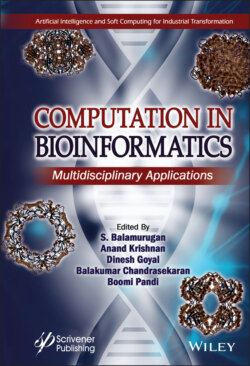Читать книгу Computation in BioInformatics - Группа авторов - Страница 32
2.2 Road Toward Advancement
ОглавлениеBioinformatic examination can fasten up the drug target identification and drug candidate screening and refinement process, and it likewise also helps in the identification of antagonistic consequences [2, 3]. High-throughput screening information, for example, genomic, epigenetic, genome design, cistromic, transcriptomic, proteomic, and ribosome profiling information have all made critical commitments possible towards advanced instrument based medication revelation and medication repurposing [3, 4].
Amassing of protein and RNA structures, just as improvement of homology demonstrating and protein structure reproduction, combined with huge structure databases of little particles and metabolites, made ready for increasingly sensible protein-ligand docking tests and progressively instructive virtual screening. In this chapter, we present the reasonable structure that drives the assortment of these high-throughput information, abridge the utility and capability of mining these information in drug discovery, diagram a couple of intrinsic impediments in information and programming mining these information, call attention to new approaches to refine examination of these various kinds of information, and feature normally utilized programming and databases applicable to substantiate drug discovery process. Bioinformaticians in novel drug discovery utilize high-throughput atomic information (Figure 2.1) having correlations between side effect transporters (patients, creature malady models, disease cell lines, and so on) and ordinary controls.
The key objectives of such comparisons are as follows [1–5]:
1 To connect side effects to hereditary transformations, epigenetic alterations, and other natural elements regulating gene expression.
2 To select and identify drug targets that can either restore cellular function or eliminate malfunctioning cells, e.g., cancer cells.
3 To foresee, refine, or rebuild treatment that can follow up on the medication focus to accomplish the planned restorative outcome and limit adverse reactions.
4 To assess the impact on environmental health and the potential of drug resistance.
Figure 2.1 High-throughput data used in bioinformatics.
Despite whether the objective of translational research is novel drug revelation, the two endpoints require the distinguishing proof of an objective or a pathway by means of fundamental or clinical research. Concentrates on the sub-atomic levels system of illness unwind focuses on that are applicable to infection advancement and movement [4, 5].
The objective ranges from proteins, molecular level changes in proteins and genes or polymorphisms in the coding or non-coding loci of the genome or transcriptional or post-translational alteration procedures. Toward one side of the objective range, characterizing the job of target is generally clearer in basic mono-factorial ailments, which are described by one causative allele, and regulating that solitary quality or factor hypothetically builds the likelihood of focusing on the problem viably. At the opposite finish of the objective range, characterizing an objective in complex multifactorial problems is very testing [4–6].
Complex infections, including disease, neurodegenerative issue, and Type 2 diabetes, are for the most part heterogeneous and have variable phenotypes from chance factors that are an element of hereditary qualities, age, sex, and diet or way of life decisions. The difficulties in distinguishing an exceptional objective fundamental complex illness emerge from cell cross-talks between flagging pathways and collaboration organizes that outcome in useful redundancies and other compensatory components [3, 5].
As the business endeavors to always improve its capacities and prescient powers in medicate/drug discovery to deliver more secure and increasingly cogent medications, it has become exceptionally evident that target data seems to be very precise to provide desire safety and efficacy later on. The significance of securing increasingly far reaching data on focuses of intrigue cannot be downplayed. An objective is considered druggable when it is agreeable to balance either through hereditary as well as experimentation. Tweak of the objective should inspire a quantifiable reaction, which sets up a solid, unequivocal connection between the objective and disease advancement or movement [1–6]. The field of target recognizable proof systems has been evaluated widely.
So, an objective in illness or pathogenesis can be estimated through the hereditary control of cells or creature model living beings utilizing bunched normally interspaced short palindromic rehashes (CRISPR-Cas9), translation activator-like effector nucleases (TALENs), and zinc-finger nucleases (ZFNs), RNA obstruction, or microRNAs. Concoction approval of the objective can be performed utilizing known mixes or accessible antibodies. The likelihood of recognizing an atom that has high capability of connecting with an objective viably requires solid objective approval information and aides in by and large hazard appraisal. The achievement of planning pertinent examine frameworks requires describing the objective in both ordinary and pathogenic states: arrangement and structure, practical or auxiliary repetition, portrayal of joined isoforms, posttranslational adjustments, subcellular dispersion, and mRNA and protein articulation levels crosswise over tissues, their half-lives, and guideline [1–4].
Target deconvolution can likewise be endeavored utilizing mass spectrometry following protein adjustment (CETSA) or partialiy enhancement strategies in the nearness or nonappearance of a medication, trailed by hereditary approval.
Target recognizable proof as of late can likewise be bolstered from extraction and incorporation of important data accessible from various datasets.
Broad research and clinical perceptions throughout the years have made accessible huge volume “omics” datasets, which may demonstrate basic in target and medication disclosure. Correlative reconciliations crosswise over omics databases are ventured to encourage the structure of increasingly extensive models of focuses in ailment. The high-throughput genomics, transcriptomics, epigenomics, proteomics, and metabolomics can help set up solid quality/protein variation affiliations and can help in biomarker revelation [7]. Eventually, models rising up out of solid correlative datasets may help distinguish right patient population and characterize important clinical endpoints for the diagnostics, avoidance, or treatment of sicknesses.
